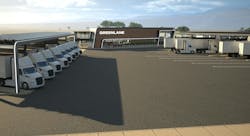Greenlane Building 280-Mile Commercial EV Charging Corridor in California for Carbon-Neutral Freight Transportation
Greenlane, a joint venture between Daimler Truck North America, NextEra Energy Resources, and BlackRock (through a fund managed by its Climate Infrastructure business), has announced a 280-mile commercial EV charging corridor along Interstate 15 with more than 100 chargers, modern amenities designed to increase driver comfort, and increased resilience for high uptime and efficient freight transport.
The new charging corridor aims to enhance the rollout of carbon-neutral freight transportation with initial charging locations in Colton, Barstow, and Baker, California. More locations will be added along the corridor, extending beyond Southern Nevada to San Pedro, California, by 2025.
“After considering various factors, such as truck telematics data, frequent freight routes, and customer deployment strategy, the Greenlane team selected these three optimal locations for our first commercial charging corridor to accelerate the transition to zero emissions,” said Patrick Macdonald-King, CEO of Greenlane. “The launch of this corridor not only marks a critical step in addressing the urgent need for publicly available, nationwide electric charging for commercial vehicles but will also serve as a model for the EV charging hubs of the future.”
The Colton site, to be located at the intersection of Interstates 10 and 215, will include over 60 chargers, including 400 kW direct current fast chargers (DCFC), to increase the charging speed of medium- and heavy-duty zero-emission vehicles (ZEVs). Additional 200 kW DCFC charging options onsite will enable long-duration and overnight charging for heavy-duty tractors, medium-duty ZEVs, and school buses.
The Colton site will also be future-proofed to accommodate the Megawatt Charging System (MCS) when it becomes commercially available. Greenlane aims to introduce the Colton site in Spring 2024 and open it in late 2024.
Greenlane will also deploy multiple passenger car charging stalls for light-duty and passenger vehicles. Future project phases will support long-duration and overnight charging lanes for tractor-trailer combinations.
The sites are designed to provide hydrogen refueling for commercial vehicles in the future.
"By using a predictive modeling tool to simulate truck traffic and energy flow at the site, we can determine how many chargers are necessary to meet the regional demand based on vehicle characteristics and departure and arrival times for vehicles hauling freight along this corridor," said Macdonald-King. "Our findings indicated that placing the three stations approximately 60 to 90 miles apart would maximize uptime for day-cab drivers by enabling shorter charging sessions at each stop and ultimately allowing customers to move freight confidently without any limitations."
About the Author
EnergyTech Staff
Rod Walton is senior editor for EnergyTech.com. He has spent 17 years covering the energy industry as a newspaper and trade journalist.
Walton formerly was energy writer and business editor at the Tulsa World. Later, he spent six years covering the electricity power sector for Pennwell and Clarion Events. He joined Endeavor and EnergyTech in November 2021.
He can be reached at [email protected].
EnergyTech is focused on the mission critical and large-scale energy users and their sustainability and resiliency goals. These include the commercial and industrial sectors, as well as the military, universities, data centers and microgrids.
Many large-scale energy users such as Fortune 500 companies, and mission-critical users such as military bases, universities, healthcare facilities, public safety and data centers, shifting their energy priorities to reach net-zero carbon goals within the coming decades. These include plans for renewable energy power purchase agreements, but also on-site resiliency projects such as microgrids, combined heat and power, rooftop solar, energy storage, digitalization and building efficiency upgrades.
